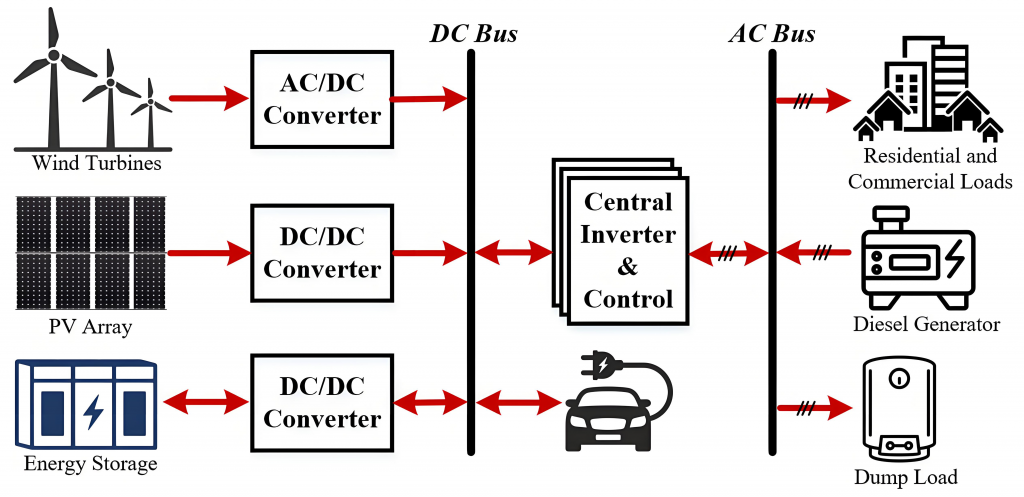Abstract:
With the rapid economic development, transportation tools such as cars, trains, and ships have occupied an important position in people’s daily lives, leading to a sharp increase in the demand for fossil energy sources like coal and oil, which brings about issues such as energy depletion and environmental pollution. In September 2020, China clearly put forward the goals of carbon peaking and carbon neutrality, vigorously developing clean energy sources such as wind, solar, and ocean energy to achieve green development. Against this backdrop, the transition of transportation tools from a fossil fuel power system dominated by internal combustion engines to a new energy power system dominated by electricity is imperative. This paper proposes a hybrid power system configuration, employing fuel cells, lithium batteries, and supercapacitors (hereinafter referred to as the three power sources) as power sources, and designs an optimization control strategy. This paper presents a comprehensive study on the design and real-time optimization control of hybrid energy storage power systems.

1. Introduction
1.1 Research Background and Significance
The economic development has led to a significant increase in the demand for transportation tools, which in turn has caused a sharp rise in the demand for fossil fuels such as coal and oil, posing serious challenges such as energy depletion and environmental pollution. In response to these issues, China has set clear goals for carbon peaking and carbon neutrality, aiming to develop clean energy sources and achieve green and sustainable development. The transition from fossil fuel-based power systems to new energy power systems dominated by electricity is inevitable. Therefore, designing an efficient and environmentally friendly hybrid energy storage power system is of great significance.
1.2 Research Status of Hybrid Power Systems
1.2.1 Research Status of System Energy Composition
Currently, hybrid power systems mostly adopt dual or triple energy source system structures, employing strategies of comprehensive energy management and independent power source control. However, these strategies struggle to address core challenges such as “multi-energy complementarity, multi-time scale responses, and multi-agent coordination” in such system structures.
1.2.2 Research Status of Optimization Control Strategies
Various MPC control strategies have been proposed, but they have limitations. For instance, some strategies require prior knowledge of vehicle driving cycles, limiting their adaptability to real-time conditions. Other strategies, such as Stochastic Model Predictive Control (SMPC) and Adaptive Model Predictive Control (AMPC), address certain issues but face challenges in real-time updating, system nonlinearity, and applicability to multi-objective control systems.
Table 1: Overview of Optimization Control Strategies
| Strategy | Advantages | Limitations |
|---|---|---|
| MPC | Good control performance | Requires pre-set points, limited real-time adaptability |
| SMPC | Real-time prediction without prior driving cycle knowledge | Non-real-time updates, weakened driving cycle adaptability |
| AMPC | Addresses system nonlinearity and uncertainty | Limited to fewer system control objectives |
1.3 Main Research Content and Structure Arrangement
This paper focuses on the design and real-time optimization control of hybrid energy storage power systems. The structure is organized as follows: Chapter 1 introduces the research background, significance, and current research status. Chapter 2 presents the dynamic modeling of the hybrid power system. Chapter 3 details the design of the optimization control strategy. Chapter 4 presents simulation studies comparing different control strategies. Finally, Chapter 5 summarizes the research and proposes future directions.
2. Dynamic Modeling of Hybrid Power System
2.1 System Architecture
The hybrid power system consists of fuel cells, lithium batteries, supercapacitors, and DC/DC converters. The system is divided into a controlled object module and an optimization control strategy module.
2.2 Power Source Modeling and Characteristic Analysis
Table 2: Key Parameters of Power Sources
| Power Source | Characteristics | Key Parameters |
|---|---|---|
| Fuel Cells | High energy density, long life | Voltage, current, efficiency |
| Lithium Batteries | High energy density, rechargeable | Capacity, state of charge (SOC), voltage |
| Supercapacitors | High power density, fast charging/discharging | Capacitance, voltage, internal resistance |
2.3 SOC Estimation and DC/DC Converter Parameter Design
The SOC of lithium batteries and supercapacitors is estimated using the Extended Kalman Filter (EKF) algorithm. The DC/DC converter parameters are optimized based on energy flow analysis under different modalities.
3. Design of Optimization Control Strategy for Hybrid Power System
3.1 Framework Analysis and Design
To address the multi-time scale response characteristics of the three power sources, this paper proposes a double-layer MPC optimization control strategy based on an event-driven mechanism.
3.2 Multi-objective Joint Optimization Cost Function
The optimization control strategy considers factors such as hydrogen fuel consumption, energy utilization efficiency, and driving performance, establishing a multi-objective joint optimization cost function. The function is solved efficiently to obtain the optimal control inputs.
3.3 Efficient Solution Analysis
The double-layer MPC integrates steady-state target calculation and dynamic optimization control. The event-driven mechanism updates the system control inputs in real-time, enhancing the system’s responsiveness and accuracy.
4. Simulation Study of System Performance under Different Control Strategies
Simulations are conducted using three control strategies: MPC, double-layer MPC, and event-driven double-layer MPC. The results demonstrate that the event-driven double-layer MPC strategy enables fast response of the three power sources and achieves high-precision real-time optimization control under multi-energy coupling constraints, enhancing system efficiency and stability.
Table 3: Simulation Results Comparison
| Control Strategy | Accuracy | Response Speed | System Efficiency |
|---|---|---|---|
| MPC | Moderate | Moderate | Moderate |
| Double-layer MPC | Higher | Higher | Higher |
| Event-driven Double-layer MPC | Highest | Highest | Highest |
5. Conclusion
The design and real-time optimization control of hybrid energy storage power systems. The proposed event-driven double-layer MPC strategy addresses core challenges such as multi-energy complementarity, multi-time scale responses, and multi-agent coordination. Simulation results validate the superiority of the proposed strategy in enhancing system efficiency, stability, and economic performance.
